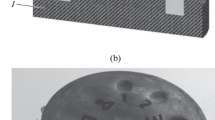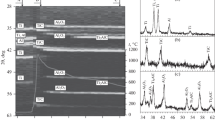Abstract
A kinetics model based on mass and heat transport has been developed for Ti3SiC2 formation via shock-activated reaction synthesis of powder precursors. The model allows prediction of heat treatment conditions under which an otherwise steady-state reaction is taken over by a “run-away” combustion-type reaction during post-shock reaction synthesis of Ti3SiC2. Shock compression of Ti, SiC, and graphite precursors generates a densely packed highly activated state of reactants, which lowers the activation energy and results in an increased rate of formation of Ti3SiC2 at a lower temperature and in shorter times. The predictive model correlated with experimental results of fraction reacted as a function of time at heat-treatment temperatures of 1400 and 1600 °C illustrates an increased rate of reaction due to lowering activation energy, which also results in the reaction at 1600 °C being taken over by a “run-away” combustion-type reaction, as the rate of heat release due to reaction exceeds the rate of heat dissipation through the compact. Correlation of the model with experimental results illustrates that the predictive model can be used to optimize reaction synthesis conditions in shock-densified compacts of Ti3SiC2-forming powder precursors, to better understand the processes leading to a steady-state reaction being taken over by the combustion mode.
Similar content being viewed by others
References
C. Racault, F. Langlais, and R. Naslain: Solid-state synthesis and characterization of the ternary phase Ti3SiC2. J. Mater. Sci. 29, 3384 (1994).
J. Lis, R. Pampuch, J. Piekarczyk, and L. Stobierski: New ceramics based on Ti3SiC2. Ceram. Int. 19, 219 (1993).
J.L. Ratliff and G.W. Powell: Research on Diffusion in Multiphase Systems and Reaction Diffusion in Ti/SiC and Ti6Al4V/SiC systems, Report AFML-TR-70-42 (U.S. Department of Commerce, Springfield, VA, 1970).
M.W. Barsoum and T. El-Raghy: Synthesis and characterization of a remarkable ceramic: Ti3SiC2. J. Am. Ceram. Soc. 79, 1953 (1966).
N.N. Thadhani: Shock induced chemical reactions and synthesis of materials. Prog. Mater. Sci. 37, 117 (1993).
J.H. Lee: Synthesis of TiC by shock-assisted solid-state reaction synthesis. Ph.D. Thesis, Georgia Institute of Technology, Atlanta, GA (1997).
S. Namjoshi: Reaction synthesis of dynamically-densified Ti-based intermetallic and ceramic forming powders. Ph.D. Thesis, Georgia Institute of Technology, Atlanta, GA (1999).
E.K. Beauchamp and M.J. Carr: Kinetics of phase change in explosively shock-treated alumina. J. Am. Ceram. Soc. 73, 49 (1990).
R.A. Graham, B. Morosin, Y. Horie, E.L. Venturini, M. Bookugh, and M.J. Carr: Chemical synthesis under high pressure shock loading, in Shock Waves in Condensed Matter, edited by Y.M. Gupta (Plenum Press, New York, NY 1984), p. 693.
Material Property Database: www.matweb.com, June 2002. Automation Creations Inc.
H.S. Carslaw and J.C. Jaeger: Conduction of Heat in Solids (Oxford University Press: Oxford, U.K., 1959), p. 20.
J.L. Jordan and N.N. Thadhani: Reaction synthesis of shock-activated Ti-based ternary Ti3SiC2 and Ti2AlN ceramics, in Powder Materials: Current Research and Industrial Practices, edited by F.D.S. Marquis, N. Thadhani, and E.V. Barrera (TMS, Warrendale, PA 2001), p. 101–111.
J. Bebernes and D. Eberly: Mathematical Problems in Combustion Theory (Springer Verlag, New York, 1989).
J.A. Pelesko and G.A. Kriegsmann: Microwave heating of ceramic composites. IMA 64, 39 (2000).
A.A. Lacey: Thermal runaway in a non-local problem modeling Ohmic heating: I. Model derivation and some special cases. Eur. J. Appl. Math. 6, 127 (1995).
J.L. Jordan: Shock-activated reaction synthesis and high pressure response of Ti-based ternary carbide and nitride ceramics. Ph.D. Thesis, Georgia Institute of Technology, Atlanta, GA (2003).
K.V. Vandersall and N.N. Thadhani: Investigation of “shock-induced” and “shock-assisted” chemical reactions in Mo+2Si powder mixtures. Metall. Mater. Trans. 34A, 15 (2003).
H.E. Kissinger: Reaction kinetics in differential thermal analysis, Anal. Chem. 29, 1702 (1957).
P.G. Boswell: On the calculation of activation energies using a modified Kissinger method. J. Therm. Anal. 18, 353 (1980).
Author information
Authors and Affiliations
Rights and permissions
About this article
Cite this article
Jordan, J.L., Pelesko, J.A. & Thadhani, N.N. Predictive kinetics-based model for shock-activated reaction synthesis of Ti3SiC2. Journal of Materials Research 20, 1476–1484 (2005). https://doi.org/10.1557/JMR.2005.0192
Received:
Accepted:
Published:
Issue Date:
DOI: https://doi.org/10.1557/JMR.2005.0192




